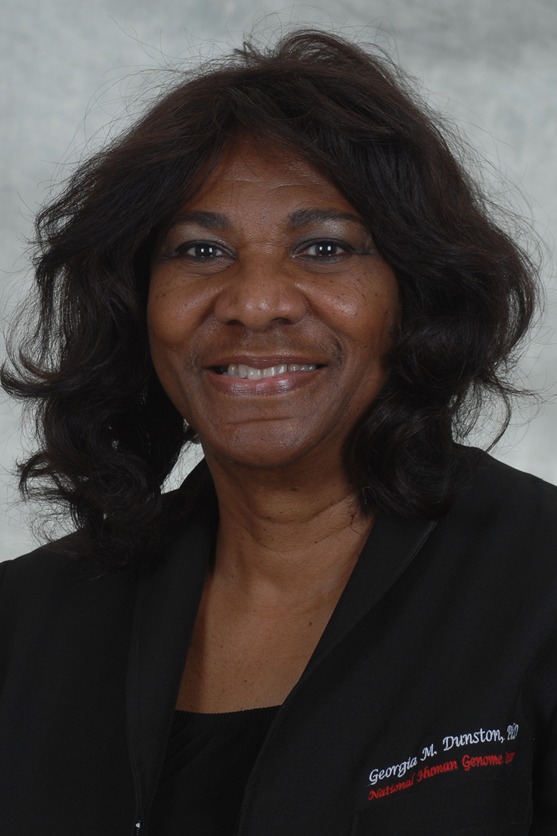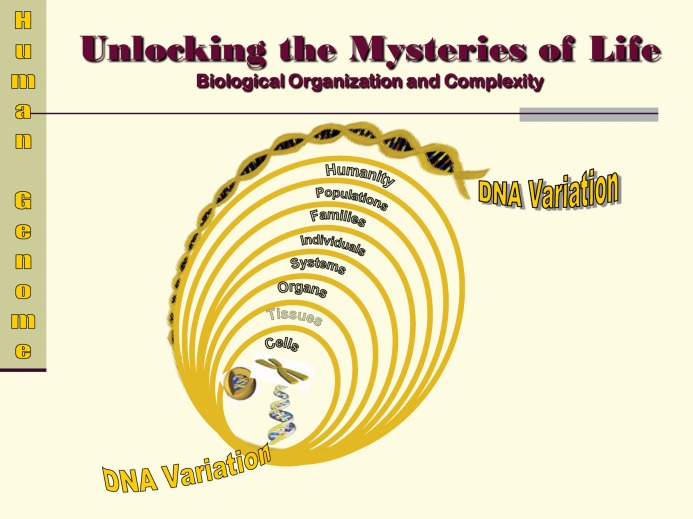Abstract
The complete sequencing of the human genome introduced a new knowledge base for decoding information structured in DNA sequence variation. My research is predicated on the supposition that the genome is the most sophisticated knowledge system known, as evidenced by the exquisite information it encodes on biochemical pathways and molecular processes underlying the biology of health and disease. Also, as a living legacy of human origins, migrations, adaptations, and identity, the genome communicates through the complexity of sequence variation expressed in population diversity. As a biomedical research scientist and academician, a question I am often asked is: “How is it that a black woman like you went to the University of Michigan for a PhD in Human Genetics?” As the ASCB 2012 E. E. Just Lecturer, I am honored and privileged to respond to this question in this essay on the science of the human genome and my career perspectives.
“Knowledge is power, but wisdom is supreme.”
THE PAST IS PROLOGUE: PRE-PHD RESEARCH INTERESTS IN THE BIOLOGY OF POPULATION DIVERSITY
With curiosity as a distinguishing characteristic of scientists, I suppose that the first cry from my mouth at birth was “Whyyyyyyy?” As far back as I can remember, my path in life and the steps in career development have been guided by a deep-rooted childhood desire to know “Why God, who loves all his children the same, made some white and others black?” This was a question etched on the heart and in the mind of a little black girl, born in Norfolk, Virginia, to working-class parents, neither of whom finished high school. In a worldview shaped largely by the black family, church, and school, my search for meaning and purpose in life, as well for answers to the seemingly paradoxical childhood questions of God's love for all his children has been a motivating force and defining factor in my life and research career. Growing up in the segregated South, I attended public schools in which my aptitude in the classroom opened the way for me to progress steadily in school, graduating at the age of 16 in the top tier of my class. This afforded me a full scholarship to the local state college. After graduating in 1965 with a BS in biology, I went to New York City seeking employment, but was soon disillusioned, after searching the whole summer with no job offers that recognized my college education. Before the Fall semester began, I returned home to Norfolk and talked with my college mentor and advisor, Dr. Louis Austin, who counseled and encouraged me to continue with my education. He informed me of an opportunity to apply for a Carver Research Foundation Fellowship for graduate school at a black college in Tuskegee, Alabama, that offered a 2-year master's of science degree in biology. With no money and no job, I was ecstatic when I received the letter of acceptance offering me a Carver Research Fellowship. At Tuskegee, I met Dr. David Aminoff, an exchange professor from the University of Michigan, who came to Tuskegee in the summer of 1967 to teach biochemistry, the only course that I needed to complete requirements for the MS. My high performance in this class prompted Dr. Aminoff to inquire about my interests in continuing my education for the terminal PhD. Because Tuskegee did not offer the doctoral degree, I had not given any particular thought to continuing graduate school after finishing the master's degree program. My thoughts were that the master's degree in biology would suffice for me to get a good job based on my education. However, Dr. Aminoff encouraged me to consider going for a PhD to complete my graduate education. Knowing the impact a student's natural curiosities can have when pursuing a research degree, Dr. Aminoff asked me what area of study intrigued me most. Without hesitation, I told him that I was most interested in understanding the basis of biological differences in black and white people. Although my interests were in studying human differences, with no investigators in the Carver Research Foundation doing research on human biological differences, I chose to work in the laboratory of Donald Shaw, an investigator studying biological differences in pigeons. For the master's thesis, I used paper chromatography and electrophoresis to study biochemical differences in DNA of two breeds of pigeons. Thus, based on my research interests and thesis work, Dr. Aminoff suggested that I consider pursuing a PhD in human genetics. To this, he added that the University of Michigan was one of only a few universities offering the PhD in Human Genetics. To further encourage me, he told me that if I wanted to come to the University of Michigan, he would give his full support to getting me accepted into the program. True to his word, upon returning to Michigan, Dr. Aminoff spoke personally to the then-chairman of the Department of Human Genetics, Dr. James V. Neel, about my academic background and recommended me for acceptance into the PhD program in human genetics. Not only was I accepted, but I was also given a traineeship that provided full financial support for my education as a graduate student in the program. This first venture for me north of the Mason-Dixon Line to attend a majority white university set the direction for my career development as a biomedical research scientist. My experience as the first and only black student in the department, with only one other black student enrolled during my tenure, was life-transforming. I was forced to confront ideas and basic questions of self-identity that put me on a collision course with my childhood images and questions of God's love. Today, with self-discovery as the“pearl of great price,” I can say with assurance that the science of the human genome and research on human genome variation now provides me with the knowledge base for demonstrating God's relentless love for the whole human family.
THE FUTURE IS NOW: POST-PHD RESEARCH ON THE BIOMEDICAL SIGNIFICANCE OF DNA POLYMORPHISM
The science of the human genome is fundamentally about life and our connection, individually and collectively, to it (see Figure 1). On completing the PhD, I was recruited by Dr. Willie Turner to a faculty position in the College of Medicine at Howard University. This appointment positioned me for the National Institutes of Health (NIH) Minority Access to Research Careers Postdoctoral Training Program, a traineeship that provided funding for my postdoctoral in tumor immunology at the National Cancer Institute in Bethesda, Maryland. The postdoctoral was critical in obtaining my first independent investigator–initiated funding as principal investigator (PI) of an NIH R01 grant. In the ensuing years, the geographic proximity of Howard to the NIH facilitated continued research collaborations with NIH investigators. The latter was significant in obtaining subsequent grant funding through the Research Centers in Minority Institutions Interdisciplinary Program to establish a laboratory at Howard for human immunogenetics research focusing on genetic variation in human major histocompatibility antigens and their associations with disease in African Americans. With the emergence of the Human Genome Project in the 1990s, I applied for and was accepted in the first group of recipients of the new Visiting Investigator's Program (VIP) in the NIH National Human Genome Research Center, now the National Human Genome Research Institute, with Dr. Francis Collins then as director. This VIP fellowship provided opportunities to meet and build research collaborations with Dr. Collins, who, in partnership with Dr. John Ruffin, was director first of the NIH Office of Research on Minority Health, then of the National Center on Minority Health and Health Disparities, and now of the National Institute for Minority Health and Health Disparities. The joint NIH–Howard University collaborative cooperation provided the scientific foundation and funding for establishing the National Human Genome Center (NHGC) in 2001 at Howard University. As the NHGC founding director, with the cooperation of NIH collaborators, I recruited an unprecedented leadership team to Howard University to develop the NHGC core research and service programs. This team included Dr. Rick Kittles, former codirector of Molecular Genetics; Dr. Charles Rotimi, former director of Genetic Epidemiology, then director of the NHGC; Dr. George Bonney, director of Statistical Genetics and Bioinformatics; and Dr. Charmaine Royal, initially PI and later the director of Genethics. With a mission to explore the science and teach the knowledge of DNA sequence variation and its interaction with the environment in the causality, prevention, and treatment of diseases common in African Americans and other African Diaspora populations, the NHGC led efforts at Howard University to build national and international research collaborations focusing on the genetics of diseases common in African Americans and other African Diaspora populations. Toward this end, the NHGC has been instrumental in bringing multicultural perspectives and resources to an understanding of knowledge gained from the Human Genome Project and research on population-based human genome variation (Keita et al., 2004; Parra et al., 2004; Rotimi, 2004; Royal and Dunston, 2004).
FIGURE 1:
DNA sequence variation encodes information fundamental to the expressions of life at all levels of biological organization and complexity, from the microcosm of invisible subatomic particles and waves to the macrocosm of the universe.
The 21st-century emergence of genomic medicine spurred by rapid advances in next-generation sequencing and bioinformatics technologies is shifting the paradigm in biomedical research and behavioral sciences from population phenotypes to individual genotypes. Recently the NHGC biophysics research and development group applied first principles of thermodynamics and statistical physics in studying the informatics of single-nucleotide polymorphisms (SNPs) as dynamic sites in the genome (Lindesay et al., 2012). Viewing SNPs as complex dynamical systems, we derived a new biophysical metric for interrogating the information content present in SNP haploblocks. This metric facilitates translation of biochemical sequence variation into a biophysical metric derived from Boltzmann's canonical ensemble used in information theory. Epidemiological studies have shown associations between common genomic variations, such as SNPs, and common diseases. Our current research strategy exploits the power of population diversity in probing the information content of the genome. The goal of this research is to better understand functional aspects of common variation and population genetics from first principles of thermodynamics and statistical physics (i.e., “genodynamics”).

Georgia M. Dunston
Abbreviations used:
- NHGC
National Human Genome Center
- NIH
National Institutes of Health
- PI
principal investigator
- SNP
single-nucleotide polymorphisms
- VIP
Visiting Investigator's Program
Footnotes
Georgia M. Dunston received the 2012 E. E. Just Award from the American Society for Cell Biology.
REFERENCES
- Keita SOY, Kittles RA, Royal CDM, Bonney GE, Furbert-Harris P, Dunston GM, Rotimi CN. Conceptualizing human variation. Nat Genetics. 2004;36:S17–S20. doi: 10.1038/ng1455. [DOI] [PubMed] [Google Scholar]
- Lindesay J, Mason T, Ricks-Santi L, Hercules W, Kurian P, Dunston G. A new biophysical metric for interrogating the information content in human genome sequence variation: proof of concept. J Comput Biol Bioinformatics Res. 2012;4:15–22. doi: 10.5897/jcbbr11.026. [DOI] [PMC free article] [PubMed] [Google Scholar]
- Parra EJ, Kittles RA, Shriver MD. Implications of correlations between skin color and genetic ancestry for biomedical research. Nat Genetics. 2004;36:S54–S60. doi: 10.1038/ng1440. [DOI] [PubMed] [Google Scholar]
- Rotimi CN. Are medical and nonmedical uses of large-scale genomic makers conflating genetics and “race”? Nat Genetics. 2004;36:S43–S47. doi: 10.1038/ng1439. [DOI] [PubMed] [Google Scholar]
- Royal CDM, Dunston GM. Changing the paradigm from “race” to human genome variation. Nat Genetics. 2004;36:S5–S7. doi: 10.1038/ng1454. [DOI] [PubMed] [Google Scholar]



